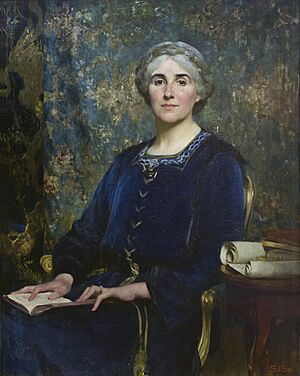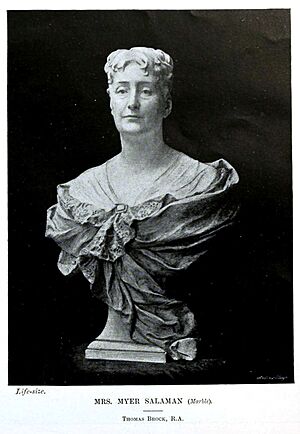Redcliffe Salaman facts for kids
Quick facts for kids
Redcliffe Salaman
|
|
|---|---|
| Born |
Redcliffe Nathan Salaman
12 September 1874 |
| Died | 12 June 1955 (aged 80) |
| Education | St Paul's School |
| Alma mater | Trinity Hall, Cambridge |
| Spouse(s) | |
| Children | 6 (incl. Raphael Salaman and Ruth Collet) |
| Scientific career | |
| Doctoral students | Jack Hawkes |
Redcliffe Nathan Salaman (born September 12, 1874 – died June 12, 1955) was a British doctor and biologist. He was a pioneer in developing potato plants that could resist diseases. Salaman also wrote an important book about the history of the potato. This book, published in 1949, helped create a new way of studying how food has influenced history.
Contents
Early Life and Education
Redcliffe Salaman was born in Kensington, London. He was one of fifteen children. His father was a rich merchant who sold ostrich feathers. This was during a time when feathers were very popular for fashion. The Salaman family were Ashkenazi Jews, who came to Britain from Europe in the early 1700s.
Salaman went to St Paul's School, London. There he studied both classic subjects and science. He became the top student in the science department. In 1893, he earned a scholarship to Trinity Hall, Cambridge. He graduated in 1896 with a top degree in Natural Sciences. He studied how living things work (physiology), animals (zoology), and chemistry.
After Cambridge, he studied medicine at the London Hospital from 1896 to 1900. He then continued his medical training in Germany in 1901-1902.
Potato Research and Discoveries
In 1903, Salaman became the Director of the Pathological Institute at the London Hospital. However, in 1904, he became sick with tuberculosis. This illness forced him to stop practicing medicine. He spent six months recovering in Switzerland.
After recovering, Salaman bought a house in Barley, Hertfordshire. Since he could not return to medicine, he started experimenting with genetics. Genetics is the study of how traits are passed down from parents to children. He began working with potatoes after getting advice from his gardener. Salaman later said he had no special love for potatoes. But he ended up spending forty years studying them.
Breeding Disease-Resistant Potatoes
Salaman first wanted to cross two potato types. He wanted to see which traits were dominant (stronger) and recessive (weaker). This was similar to what Gregor Mendel did with peas. But Salaman soon started exploring other areas.
In 1908, he began including wild potatoes in his experiments. He found that a wild potato called Solanum demissum was resistant to a serious disease. This disease is called late blight (Phytophthora infestans). Late blight can destroy entire potato crops.
Starting in 1911, Salaman crossed S. demissum with common potato types. His goal was to create new potatoes that grew well and could also resist late blight. By 1914, he had successfully created these new types. In 1926, he proudly noted that he had produced potatoes that were "immune to late blight."
Salaman was the first to find a genetic way to resist late blight. Even in the 1950s, S. demissum was still used to help breed resistant potatoes. His discovery was a major breakthrough. By 1987, about half of the potato types grown in Europe had genes from S. demissum.
Other Potato Studies
In 1910, Salaman published a paper on how color is inherited in potatoes. He also studied other topics related to potatoes. These included how to estimate crop yields and how to find viruses in potato seeds.
His potato research was interrupted by the First World War. Salaman served in the army medical corps in Palestine. After the war, he helped describe different potato types. This work stopped people from selling old potatoes under new names. He published a book called Potato Varieties in 1926.
In the same year, he convinced the Ministry of Agriculture to create the Potato Virus Research Institute in Cambridge. He directed this institute until 1939. His work on viruses led to him being chosen for the Royal Society in 1935.
The History and Social Influence of the Potato
Salaman wrote a very important book called The History and Social Influence of the Potato. It was first published in 1949. This book covers every part of the history of the potato. It especially focuses on Ireland, where the potato had a huge impact.
Reviewers called it an "unusual and vastly interesting book." It combined genetics, history, and archaeology. One paper noted that because of Salaman's book, we know more about how the potato changed people's lives. This was especially true for poor people.
Community Involvement and Political Views
Salaman was a strong supporter of Zionism. This is the idea of a Jewish homeland. In 1907, he became president of the English Zionist Federation.
He was also active in the Jewish community. He was president of the Jewish Historical Society. He helped found the Jewish Health Organization of Great Britain. He was also a member of the board of governors for the Hebrew University of Jerusalem.
In 1933, Salaman helped start the Academic Assistance Council. This group helped scientists who were escaping the Nazi regime. In 1945, he led the Jewish Committee for Relief Abroad. This group worked to help survivors of the concentration camps.
Personal Life

On October 23, 1901, Salaman married Nina Ruth Davis. She was a scholar of the Hebrew language. They had six children together. One of their children, Raphael Salaman, became an engineer. Another, Ruth Collet, became an artist.
They lived in the village of Barley in Hertfordshire. Nina Salaman continued her interest in medieval Hebrew poetry. She made sure their home followed Jewish traditions. Sadly, Nina died in 1925. In 1926, Salaman married Gertrude Lowy, who survived him.
Images for kids




